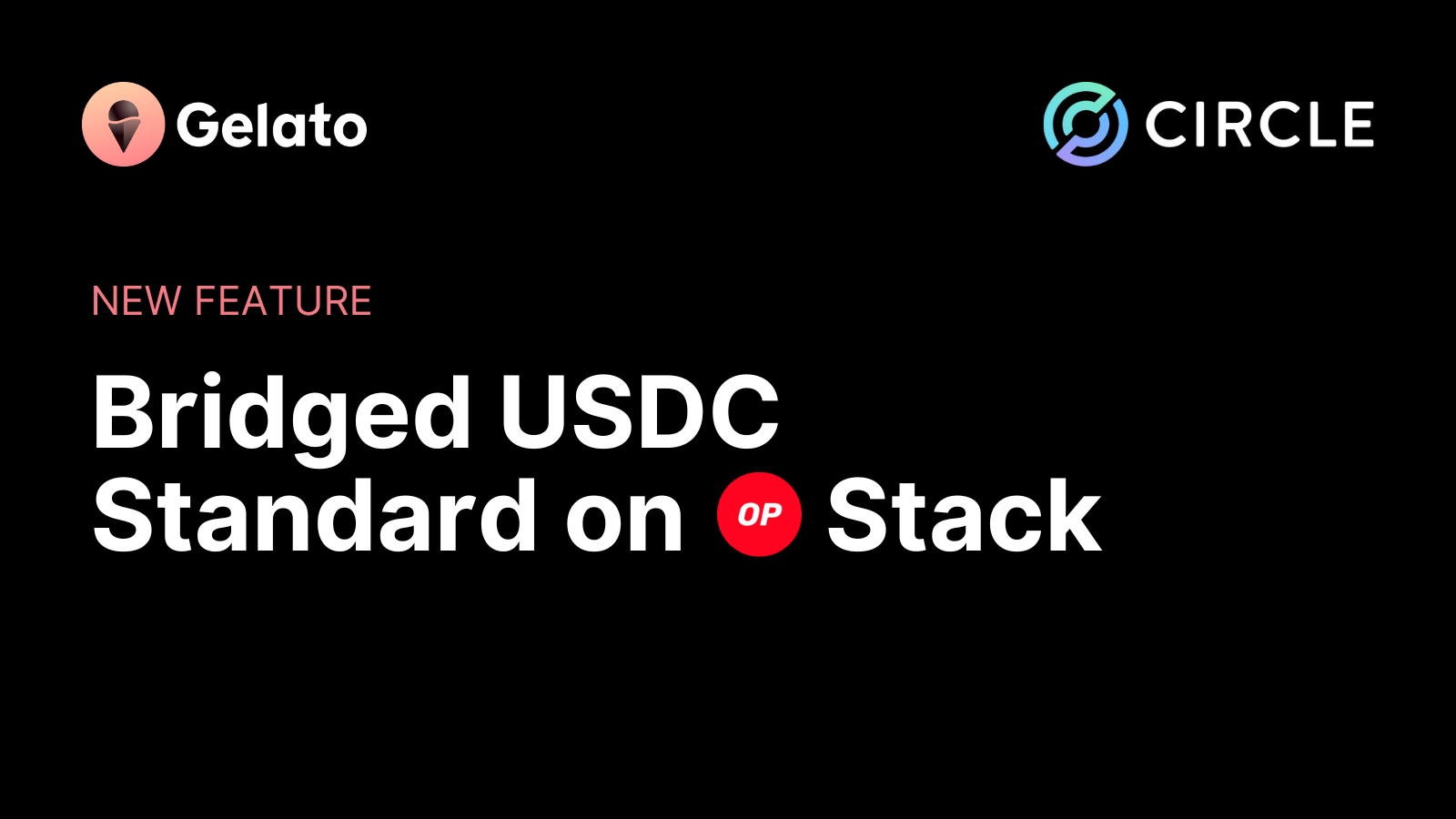256 days ago
Enabling Bridged USDC Standard on Gelato RaaS OP chains
 Stablecoins are the backbone of the onchain economy. They allow traders to manage their assets in a stable, dollar-pegged form, which is important for taking profits, sidestepping market volatility, reliable medium of exchange, or simply holding value until the next big opportunity arises.
Stablecoins are the backbone of the onchain economy. They allow traders to manage their assets in a stable, dollar-pegged form, which is important for taking profits, sidestepping market volatility, reliable medium of exchange, or simply holding value until the next big opportunity arises.
USDC is one of the most popular stablecoins, and as a result, it’s often bridged to other networks, leading to the existence of different versions of USDC like USDC.e on Avalanche and USDbC on Base that can sometimes be confusing and fragment liquidity.
To address this, OP Stack created a reference implementation for deploying the Bridged USDC Standard on OP Stack chains, enabling optionality for a future upgrade from Bridged USDC to Native USDC and eliminating the complexities associated with managing multiple USDC versions.
Gelato is integrating the Bridged USDC Standard across its existing OP chains—Ethernity, Lisk, Camp, GameSwift—as well as on upcoming OP Stack deployments, enabling users and builders to tap into USDC on the Superchain.
But to fully understand what this integration enables, it’s important to first understand the difference between Native USDC and Bridged USDC.
What is Native USDC?
Native USDC is the original form of USD Coin (USDC) issued directly by Circle, a regulated fintech company. It is fully backed by US dollars, ensuring that each USDC is always redeemable 1:1 for real dollars. Native USDC is the official and trusted version of USDC on any blockchain where it is issued and is interoperable across multiple networks via Circle’s Cross-Chain Transfer Protocol (CCTP). Circle has expanded Native USDC to 15 networks.
What is Bridged USDC?
Bridged USDC is a copy of Native USDC created when the original is locked on its home network and replicated on another using bridge protocols. Unlike Native USDC, these bridged versions aren’t directly connected to Circle’s dollar reserves and can’t always be redeemed for actual dollars. These bridged tokens carry more risk.
The Role of Bridged USDC in New Networks
Bridged USDC offers a quick solution by allowing new L1 and L2 chain teams, as well as third-party bridge deployers, to bootstrap stablecoin liquidity. Although these bridged versions are unofficial and not directly redeemable by Circle, they serve as a crucial proxy, enabling early-stage ecosystem development and user engagement.
As L2s, L3s, and modular blockchains have become more common, it's sometimes the case that significant USDC liquidity is bridged by third parties before Circle can issue Native USDC.
While migrating from Bridged USDC to Native USDC is possible, it is far from ideal due to the potential fragmentation of liquidity and the complexities involved in migration.
To address this, the Bridged USDC Standard was introduced by Circle, “It is a specification and process for deploying a bridged form of USDC on EVM blockchains with optionality for Circle to seamlessly upgrade to native issuance in the future.”
In simple language, Bridged USDC Standard is a framework that allows the creation of bridged USDC on EVM blockchains where native USDC is not deployed, with the option for an easy upgrade to native USDC by Circle in the future.
Challenges with USDC on OP Stack Chains
However, the Bridged USDC Standard wasn’t compatible with the OP Stack bridge. This created confusion among chain operators on how to safely get USDC on their chain. Without a clear upgrade path, chains risked dealing with fragmented liquidity, user confusion, and security vulnerabilities.
To address these issues, OP Stack is now compatible with Bridges USDC standard. This solution ensurers that they are prepared for future upgrades to Native USDC.
What Does This Enable?
Upgradeability: The standard facilitates a smooth transition from bridged USDC to native USDC issuance if and when Circle decides to upgrade. This eliminates the complexities and potential disruptions associated with migrating between bridged and native versions, ensuring that developers and users can benefit from native USDC without additional migration challenges.
Unified Liquidity: By adopting the Bridged USDC Standard, OP Stack chains can consolidate liquidity around a single form of bridged USDC. This reduces liquidity fragmentation that can occur with multiple bridges and standards.
Secure and Audited: The Bridged USDC Standard is based on the audited ERC-20 contract code, which has been rigorously tested and secured billions of dollars in liquidity. This provides confidence in the security and integrity of the bridged USDC.
No User Disruption: Users don’t need to swap tokens; upgrades to Native USDC happen automatically, ensuring a smooth transition.
By implementing this standard on existing and upcoming Gelato OP Chains users and builders can tap into USDC on the Superchain!
Deploy On Gelato
To learn how Gelato can help you deploy your chain on the OP Stack, schedule a meeting here, or simply deploy with just one click OP Stack chain on the Gelato RaaS app.

